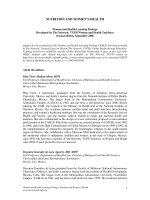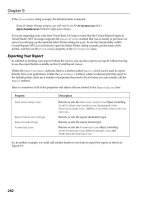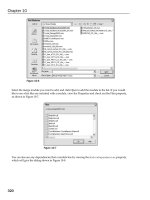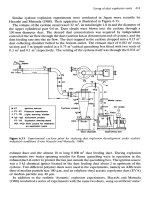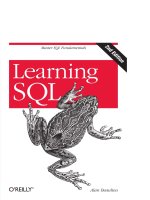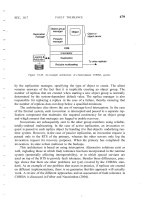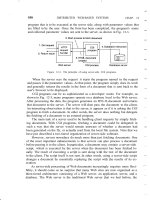SECOND EDITION COMPREHENSIVE DICTIONARY docx
Bạn đang xem bản rút gọn của tài liệu. Xem và tải ngay bản đầy đủ của tài liệu tại đây (5.78 MB, 769 trang )
COMPREHENSIVE
DICTIONARY
OF
SECOND EDITION
© 2005 by Taylor & Francis Group, LLC
CRC PRESS, a Taylor & Francis title, part of the Taylor and Francis Group.
Boca Raton London New York Singapore
COMPREHENSIVE
DICTIONARY
OF
SECOND EDITION
EDITOR-IN-CHIEF
Phillip A. Laplante
© 2005 by Taylor & Francis Group, LLC
Published in 2005 by
CRC Press
Taylor & Francis Group
6000 Broken Sound Parkway NW, Suite 300
Boca Raton, FL 33487-2742
© 2005 by Taylor & Francis Group, LLC
CRC Press is an imprint of Taylor & Francis Group
No claim to original U.S. Government works
Printed in the United States of America on acid-free paper
10987654321
International Standard Book Number-10: 0-8493-3086-6 (Hardcover)
International Standard Book Number-13: 978-0-8493-3086-5 (Hardcover)
Library of Congress Card Number 2004058572
This book contains information obtained from authentic and highly regarded sources. Reprinted material is quoted with
permission, and sources are indicated. A wide variety of references are listed. Reasonable efforts have been made to publish
reliable data and information, but the author and the publisher cannot assume responsibility for the validity of all materials
or for the consequences of their use.
No part of this book may be reprinted, reproduced, transmitted, or utilized in any form by any electronic, mechanical, or
other means, now known or hereafter invented, including photocopying, microfilming, and recording, or in any information
storage or retrieval system, without written permission from the publishers.
01923, 978-750-8400. CCC is a not-for-profit organization that provides licenses and registration for a variety of users. For
organizations that have been granted a photocopy license by the CCC, a separate system of payment has been arranged.
Trademark Notice: Product or corporate names may be trademarks or registered trademarks, and are used only for
identification and explanation without intent to infringe.
Library of Congress Cataloging-in-Publication Data
Comprehensive dictionary of electrical engineering / editor-in-chief Phillip A. Laplante 2nd ed.
p. cm.
ISBN 0-8493-3086-6 (alk. paper)
1. Electric engineering Dictionaries. I. Title: Electrical engineering. II. Laplante, Phillip A.
TK9.C575 2005
621.3'03 dc22 2004058572
Visit the Taylor & Francis Web site at
and the CRC Press Web site at
Taylor & Francis Group
is the Academic Division of T&F Informa plc.
© 2005 by Taylor & Francis Group, LLC
For permission to photocopy or use material electronically from this work, please access www.copyright.com
( or contact the Copyright Clearance Center, Inc. (CCC) 222 Rosewood Drive, Danvers, MA
Preface to the Second
Edition
Since the publication of the first edition of this dictionary more than 5 years ago, many changes in
technology have occurred, particularly in the rapidly changing fields of image processing, computer
electronics, fuel cells, and nanotechnology. I must say, however, that preparing the second edition of
to prepare because, fortunately, I had a set of handy resources that included terms related to these tech-
nological changes. That is, I was able to incorporate new terms from the many new CRC handbooks
published within the last 2 years including, the Fuel Cell Technology Handbook, Electric and Hybrid
Vehicles: Design Fundamentals, The Computer Engineering Handbook, Digital Color Imaging Hand-
book, Handbook of Nanoscience Engineering and Technology, The RF and Microwave Handbook, The
Power Electronics Handbook, Biomedical Photonics Handbook, and The Mechatronics Handbook.Iwas
also able to incorporate new terms and corrections suggested by readers of the first edition (for which I
heartily thank those readers), as well as additions and corrections that are invariably needed after even
the fifth read-through.
In total, more than 1500 terms were added, updated, expanded, improved, or corrected, resulting
in a dictionary with over 11,000 terms and abbreviations related to electrical engineering. However, if
readers discover any errors or think that any important terms have been omitted, please inform me at
printings and editions.
In keeping within the scope established with the first edition, most terms pertaining to computer
science, information technology, and software engineering that are not directly linked to the underlying
hardware were omitted. For these, please refer to Comprehensive Dictionary of Computer Science,
Engineering and Technology (CRC Press).
Once again I want to thank Nora Konopka and the fine editorial and production staff at Taylor &
Francis, especially Helena Redshaw and Amy Rodriguez, for helping to bring this second edition into
being. These folks have always been a pleasure to work with.
Finally, I want to thank my family for their patience and support as I worked countless hours on this
project, which most certainly would never have been completed without their blessing. Therefore, this
dictionary is dedicated to Nancy, Christopher, and Charlotte.
Phillip A. Laplante, P.E., Ph.D.
© 2005 by Taylor & Francis Group, LLC
this dictionary was significantly easier than the first edition (see preface to first edition). It was easier
with your proposed changes. I will be happy to consider those changes for future
Preface to the First
Edition
One can only appreciate the magnitude of effort required to develop a dictionary by actually experiencing
it. Although I had written nine other books, I certainly did not know what I was getting into when in
January of 1996 I agreed to serve as Editor-in-Chief for this project. Now, after 2
1
2
years I understand.
Unlike other books that I have written, creating this dictionary was more a test of will and stamina
and an exercise in project management than mere writing. And although I have managed organizations
of up to 80 academics, nothing is more like “herding cats” than motivating an international collection
of more than 100 distinguished engineers, scientists, and educators scattered around the globe almost
entirely via email. Yet, I think there is no other way to undertake a project like this. I still marvel at how
Noah Webster must have managed to construct his English Dictionary without the benefits of modern
communication.
But this project, as much as it is a monument to individual will, is really the collaborative work of
many brilliant and dedicated men and women. This is their dictionary and your dictionary.
Phillip A. Laplante, P.E., Ph.D.
Editor-in-Chief
© 2005 by Taylor & Francis Group, LLC
Foreword
How was the dictionary constructed?
As I knew this project would require a divide-and-conquer approach with fault-tolerance, I sought to
partition the dictionary by defining areas that covered all aspects of electrical engineering. I then matched
these up to IEEE-defined interest areas to ensure that complete coverage was provided. This created a
great deal of overlap, which was intentional. I knew that terms needed to be defined several different
ways, depending on usage, and I needed to ensure that every term would be defined at least once.
The mapping of the dictionary’s areas to the IEEE interest areas are as follows:
Power systems
●
Power engineering
●
Power electronics
Electric motors and machines
●
Power engineering
●
Power electronics
Digital electronics, VLSI, hardware
description language
●
Consumer electronics
●
Electronic devices
●
Industrial electronics
●
Instruments and measurements
Microelectronics and solid state devices
●
Industrial electronics
●
Instruments and measurements
RF, radio, and television
●
Broadcast technology
Communications and information processing
●
Communications
●
Information theory
●
Systems, man, and cybernetics
●
Reliability
Signal and image processing
●
Signal processing
●
Systems, man, and cybernetics
Circuits and systems
●
Circuits and systems
●
Instruments and measurements
Control systems
●
Control systems
●
Robotics and automation
Electromagnetics
●
Electromagnetic compatibility
●
Magnetics
Computer engineering (processors)
●
Computer
Computer engineering (I/O and storage)
●
Computer
Microwave systems
●
Antennas and propagation
●
Microwave theory and techniques
Electro-optical and lightwave systems
●
Lasers and electro-optics
Illumination
Properties of materials
●
Dielectrics and electrical insulation
Packaging
●
Components, packaging
●
Manufacturing technology
Note that software engineering was not included as an area, and most software terms have been
omitted. Those that were included were done so because they relate to some aspect of assembly language
© 2005 by Taylor & Francis Group, LLC
programming or low-level control, or artificial intelligence and robotics. For those interested in software
engineering terms, CRC’s Comprehensive Dictionary of Computer Science, Engineering, and Technology
includes those terms.
Several other IEEE interest areas werenotexplicitly assigned to area editors.However, after discussing
this fact with the editorial board, it was decided that relevant terms of a general nature would be picked
up and terms that were not tagged for the dictionary from these areas were probably too esoteric to be
included.
These interest areas encompass:
Aerospace and electronic systems
Education
Engineering in medicine and biology
Engineering management
Professional communications
Social implications of technology
Geosience and remote sensing
Industry applications
Nuclear and plasma science
Oceanic engineering
Ultrasonic, ferroelectrics, and frequency control
Vehicular technology
Given the area editor structure, constructing the dictionary then consisted of the following steps:
1. Creating a terms list for each area
2. Defining terms
3. Cross-checking terms within areas
4. Cross-checking terms across areas
5. Compiling and proofing the terms and definitions
6. Reviewing compiled dictionary
7. Final proofreading
The first and most important task undertaken by the area editors was to develop a list of terms to be
defined. A terms list is a list of terms (without definitions), proper names (such as important historical
figures or companies), or acronyms relating to electrical engineering. What went into each terms list
was left to the discretion of the area editor based on the recommendations of the contributing authors.
However, lists were to include all technical terms that relate to the area (and subareas). Technical terms
of a historical nature were only included if it was noted in the definition that the term is “not used” in
modern engineering or that the term is “historical” only. Although the number of terms in each list varied
somewhat, each area’s terms list consisted of approximately 700 items.
Once the terms lists were created, they were merged and scrutinized for any obvious omissions. These
missing terms were then assigned to the appropriate area editor. At this point the area editors and their
contributing authors (there were 5 to 20 contributing authors per area) began the painstaking task of term
definition. This process took many months. Once all of the terms and their definitions were collected, the
process of converting, merging, and editing began.
The dictionary included contributions from over 100 contributors from 17 countries. Although authors
were provided with a set of guidelines to write terms definitions, they were free to exercise their own
judgment and tousetheir own style. As a result, the entries vary widely incontent from short, one-sentence
definitions torather longdissertations. While Itried toprovide somehomogeneity inthe process ofediting,
I neither wanted to tread on the feet of the experts and possibly corrupt the meaning of the definitions
(after all, I am not an expert in any of the representative areas of the dictionary) nor did I want to interfere
with the individual styles of the authors. As a result, I think the dictionary contains a diverse and rich
exposition that collectively provides good insights into the areas intended to be covered by the dictionary.
© 2005 by Taylor & Francis Group, LLC
Moreover, I was pleased to find the resultant collection much more lively, personal, and user-friendly
than typical dictionaries.
Finally, we took advantage of the rich CRC library of handbooks, including The Control Handbook,
Electronics Handbook, Image Processing Handbook, Circuits and Filters Handbook, and The Electrical
Engineering Handbook, to pick up any definitions that were missing or incomplete. About 1000 terms
were take from the CRC handbooks. We also borrowed, with permission from IEEE, about 40 definitions
that could not be found elsewhere or could not be improved upon.
Despite the incredible support from my area editors, individual contributors, and staff at CRC Press,
the final tasks of arbitrating conflicting definitions, rewording those that did not seem descriptive enough,
and identifying missing ones were left to me. I hope that I have not failed you terribly in my task.
How to use the dictionary
The dictionary is organized like a standard language dictionary except that not every word used in the
dictionary is defined (this would necessitate a complete embedding of an English dictionary). However,
we tried to define most non-obvious technical terms used in the definition of another term.
In some cases more than one definition is given for a term. These are denoted (1), (2), (3), , etc.
Multiple definitions were given in cases where the term has multiple distinct meanings in differing fields,
or when more than one equivalent but uniquely descriptive definition was available to help increase
understanding. In a few cases, I just couldn’t decide between two definitions. Pick the definition that
seems to fit your situation most closely. The notation 1., 2., etc. is used to itemize certain elements of a
definition and are not to be confused with multiple definitions.
Acronym terms are listed by their expanded name. Under the acronym the reader is referred to that
the definition can be found. The only exceptions are in the cases where the expanded acronym might not
make sense, or where the acronym itself has become a word (such as “laser” or “sonar”).
While I chose to include some commonly used symbols (largely upon the recommendations of the
contributors and area editors), this was not a principle focus of the dictionary and I am sure that many
have been omitted.
Finally, we tried to avoid proprietary names and tradenames where possible. Some have crept in
because of their importance, however.
Acknowledgments
A project of this scope literally requires hundreds of participants. I would like to take this moment to
thank these participants both collectively and individually. I thank, in no particular order:
●
The editorial board members and contributors. Although not all participated at an equal level,
all contributed in some way to the production of this work.
●
Ron Powers, CRC President of Book Publishing, for conceiving this dictionary, believing in
me, and providing incredible support and encouragement.
●
Frank MacCrory, Norma Trueblood, Nora Konopka, Carole Sweatman, and my wife Nancy
for converting, typing, and/or entering many of the terms.
© 2005 by Taylor & Francis Group, LLC
term. For example, if you look up “RISC” you will find “See reduced instruction set computer,” where
●
Jill Welch, Nora Konopka, Ron Powers, Amy Rodriguez, Susan Fox, Karen Feinstein,
Joe Ganzi, Gerry Axelrod, and others from CRC for editorial support.
●
CRC Comprehensive Dictionary of Mathematics and CRC Comprehensive Dictionary of
Physics editor Stan Gibilisco for sharing many ideas with me.
●
My friend Peter Gordon for many of the biographical entries.
●
Lisa Levine for providing excellent copy editing of the final manuscript.
Finally to my wife Nancy and children Christopher and Charlotte for their incredible patience and
endurance while I literally spent hundreds of hours to enable the birth of this dictionary. This achievement
is as much theirs as it is mine.
Please accept my apologies if anyone was left out—this was not intentional and will be remedied in
future printings of this dictionary.
How to Report Errors/Omissions
Because of the magnitude of this undertaking and because we attempted to develop new definitions
completely from scratch, we have surely omitted (though not deliberately) many terms. In addition, some
definitions are possibly incomplete, weak, or even incorrect. But we wish to evolve and improve this
dictionary in subsequent printings and editions. You are encouraged to participate in this collaborative,
global process. Please send any suggested corrections, improvements, or new terms to be added (along
incorporated, you will be recognized as a contributor in future editions of the dictionary.
References
[1] Attasi, Systemes lineaires homgenes a deux indices, IRIA Rapprot Laboria, No. 31, Sept. 1973.
[2] Baxter, K., Capacitive Sensors, IEEE Press, 1997.
[3] Biey and Premoli, A., Cauer and MCPER Functions for Low-Q Filter Design, St. Saphorin: Georgi,
1980.
[4] Bishop, Robert, The Mechatronics Handbook, Boca Raton: CRC Press, 2002.
[5] Blostein, L., Some bounds on the sensitivity in RLC networks, Proceedings of the 1st Allerton
Conference on Circuits and Systems Theory, 1963, pp. 488–501.
[6] Boutin, A.C., The misunderstood twin-T oscillator, IEEE Circuits and Systems Magazine, Dec.
1980, pp. 8–13.
[7] Chen, W K., Ed., The Circuits and Filters Handbook, Boca Raton, FL: CRC Press, 1995.
[8] Clarke and Hess, D.T., Communication Circuits: Analysis and Design, Addison-Wesley, 1971.
[9] Coultes, E. and Watson, W., Synchronous machine models by standstill frequency response tests,
IEEE Transactions on Power Apparatus and Systems, PAS 100(4), 1480–1489, 1981.
[10] Dorf, R.C., Ed., The Electrical Engineering Handbook, 2nd ed., Boca Raton, FL: CRC Press, 1997.
[11] Enslow, H., Multiprocessor organization, Computing Surveys, 9(1), 103–129, 1977.
[12] Filanovsky, M., Piskarev, V.A., and Stromsmoe, K.A., Nonsymmetric multivibrators with an aux-
iliary RC-circuit, Proc. IEEE, 131, 141–146, 1984.
[13] Filanovsky, M. and Piskarev, V.A., Sensing and measurement of dc current using a transformer and
RL-multivibrator, IEEE Trans. Circ. Syst., 38, 1366–1370, 1991.
© 2005 by Taylor & Francis Group, LLC
with suggested definitions) to me at or If your submission is
[14] Filanovsky, M., Qiu, S S., and Kothapalli, G., Sinusoidal oscillator with voltage controlled fre-
quency and amplitude, Intl. J. Electron., 68, 95–112, 1990.
[15] Frerking, C., Oscillator Design and Temperature Compensation, Van Nostrand Reinhold, 1978.
[16] Fornasini and Marchesini, G., Double-indexed dynamical systems, Mathematical Systems Theory,
1978, pp. 59–72.
[17] Franco, Design with Operational Amplifiers and Analog Integrated Circuits, McGraw-Hill, 1988.
[18] Goddard III, William A., Brenner, Donald W., Lyshevski, Sergey Edward, and Iafrate, Gerald (Eds.),
Handbook of Nanoscience Engineering and Technology, Boca Raton: CRC Press, 2003.
[19] Golio, Mike (Ed.), The RF and Microwave Handbook, Boca Raton: CRC Press, 2001.
[20] Hoogers, Gregor (Ed.), Fuel Cell Technology Handbook, Boca Raton: CRC Press, 2003.
[21] Held, N. and Kerr, A.R., Conversion loss and noise of microwave and millimeter-wave mixers:
Part 1, Theory and Part 2, Experiment, IEEE Transactions on Microwave Theory and Techniques,
MTT-26, 49, 1978.
[22] Hennessy, L. and Patterson, D.A., Computer Architecture: A Quantitative Approach, 2nd ed.,
Kaufmann, 1996.
[23] Huelsman, P.and Allen, P.E.,Introduction to the Theory and Design of Active Filters, McGraw-Hill,
1980.
[24] Husain, Iqbal, Electric and Hybrid Vehicles: Design Fundamentals, Boca Raton: CRC Press, 2003.
[25] Huising, H., Van Rossum, G.A., and Van der Lee, M., Two-wire bridge-to-frequency converter,
IEEE J. Solid-State Circuits, SC-22, 343–349, 1987.
[26] IEEE Committee Report, Proposed excitation system definitions for synchronous machines, IEEE
Transactions on Power Apparatus and Systems, PAS-88(8), August 1969.
[27] IEEE Standard Dictionary of Electrical Engineering, 6th ed., 1996.
[28] Jouppi, N.P., The nonuniform distribution of instruction-level and machine prallelism and its effect
on performance, IEEE Transactions on Computers, 38(12), 1645–1658, Dec, 1989.
[29] Kaczorek, Linear Control Systems, Vol. 2, New York: John Wiley & Sons, 1993.
[30] Kaczorek, The singular general model of 2-D systems and its solution, IEEE Transactions on
Automatic Control, AC-33(11), 1060–1061, 1988.
[31] Kaczorek, Two-Dimensional Linear Systems, Springer-Verlag, 1985.
[32] Kaplan, -Z., Saaroni, R., and Zuckert, B., Analytical and experimental approaches for the design of
low-distortion Wien bridge oscillators, IEEE Transactions on Instrumentation and Measurement,
IM-30,147–151, 1981.
[33] Katevenis, G.H., Reduced Instruction Set Computer Architectures for VLSI, MIT Press, 1985.
[34] Kurek, The general state-space model for a two-dimensional linear digital system, IEEE Transac-
tions on Automatic Control, AC-30(6), 600–601, 1985.
[35] Krause, C., Wasynczuk, O., and Sudhoff, S.D., Analysis of Electric Machinery, IEEE Press, 1995.
[36] Levine, W.S., Ed., The Control Handbook, Boca Raton, FL: CRC Press, 1995.
[37] Morf, Levy, B.C., and Kung, SY., New results in 2-D systems theory, Proc. IEEE, 65(6), 861–872,
1977.
[38] Myers, J., Advances in Computer Architecture, 2nd ed., New York: John Wiley & Sons, 1982.
[39] Neubert, K.P., Instrument Transducers, Clarendon Press, 1975.
[40] Oklobdzija, Voijin G. (Ed.), The Computer Engineering Handbook, Boca Raton: CRC Press, 2002.
[41] Qiu, S S. and Filanovsky, I.M., Periodic solutions of the Van der Pol equation with moderate values
of damping coefficient, IEEE Transactions on Circuits and Systems, CAS-34, 913–918, 1987.
[42] Orchard, J., Loss sensitivities in singly and doubly terminated filters, IEEE Transactions on
Circuits and Systems, CAS-26, 293–297, 1979.
© 2005 by Taylor & Francis Group, LLC
[43] Pallas-Ar´any and Webster, J.G., Sensor and Signal Conditioning, New York: John Wiley & Sons,
1991.
[44] Patterson, A. and Ditzel, D.R., The case for the RISC, Computer Architecture News, 8(6), 25–33,
1980.
[45] Patterson, A. and Sequin, C.H., A VLSI RISC, IEEE Computer, 15(9), 8–21, 1982.
[46] Pederson, O. and Mayaram, K., Analog Integrated Circuits for Communication, Kluwer, 1991.
[47] Radin, The 801 Minicomputer, IBM J. Res. Devel., 21(3), 237–246, 1983.
[48] Ramamurthi and Gersho, A., IEEE Transactions on Communications, 34(1), 1105–1115, 1986.
[49] Roesser, P., A discrete state-space model for linear image processing, IEEE Transactions on
Automatic Control, AC-20(1),1–10, 1975.
[50] Russ, J.C., Ed., The Image Processing Handbook, 2nd ed., Boca Raton, FL: CRC Press, 1994.
[51] Rosenbrock, H.H., Computer-Aided Control System Design, Academic Press, 1974.
[52] Sharma, Gaurav (Ed.), Digital Color Imaging Handbook, Boca Raton: CRC Press, 2003.
[53] Skvarenina, Timothy L. (Ed.), The Power Electronics Handbook, Boca Raton: CRC Press, 2002.
[54] Smith, Modern Communication Circuits, McGraw-Hill, 1986.
[55] Strauss, Wave Generation and Shaping, 2nd ed., McGraw-Hill, 1970.
[56] Tabak, RISC Systems and Applications, Research Studies Press and Wiley, 1996.
[57] Thomas and Clarke, C.A., Eds., Handbook of Electrical Instruments and Measuring Techniques,
Prentice-Hall, 1967.
[58] Vo-Dinh, Tuan, Biomedical Photonics Handbook, Boca Raton: CRC Press, 2003.
[59] Whittaker, J.C., Ed., The Electronics Handbook, Boca Raton, FL: CRC Press, 1996.
[60] Youla and Gnavi, G., Notes of n-dimensional system theory, IEEE Transactions on Circuits and
Systems, 26(2), 105–111, 1979.
© 2005 by Taylor & Francis Group, LLC
Editor-in-Chief
Phillip A. Laplante, Ph.D. is associate professor of software engineering at Pennsylvania State’s Great
Valley Graduate Center.In this capacity heconducts research and teachesgraduate courses in software and
computer systems engineering. He also serves as the chief technology officer for the Eastern Technology
Council and founded and leads its CIO community of practice, the CIO Institute.
Before joining Penn State, Dr. Laplante was president of Pennsylvania Institute of Technology, a
2-year, private college that focuses on technology training and retraining. Prior to that, he was the
founding dean of the BCC/NJIT Technology and Engineering Center in southern New Jersey. He was
also associate professor of computer science and chair of the Mathematics, Computer Science and Physics
Department at Fairleigh Dickinson University in New Jersey.
In addition to his academic career, Dr. Laplante spent almost 8 years as a software engineer and project
manager working on avionics (including the space shuttle), computer-aided design (CAD), and software
test systems. He has published more than 120 papers and articles and 20 books, including Dictionary
of Computer Science, Engineering, and Technology and Software Engineering for Image Processing
Systems, both through CRC Press. He also edits two book series, including the Image Processing series
for CRC Press, and cofounded the journal Real-Time Imaging, which he edited for 5 years.
Dr. Laplante earned his B.S., M.Eng., and Ph.D. in computer science, electrical engineering, and
computer science, respectively, from Stevens Institute of Technology, and an M.B.A. from the University
of Colorado. He is a senior member of IEEE and a member of numerous other professional societies,
program committees, and boards, and is a licensed professional engineer in Pennsylvania.
© 2005 by Taylor & Francis Group, LLC
Editorial Board
Mike Fiddy
University of Massachusetts, Lowell
Editor: Electro-optical and lightwave systems
Mike Golio
Rockwell Collins
Editor: Microwave systems
Marco Gori
University of Florence
Associate Editor: Information processing
Ling Guan
University of Sydney
Editor: Communications and information
processing
Bob Herrick
Purdue University
Editor: RF, radio, and television
Jeff Honchell
Purdue University
Associate Editor: RF, radio, and television
Jin Jiang
University of Western Ontario
Editor: Circuits and systems
Tadeusz Kaczorek
Warsaw University of Technology
Editor: Control systems
Andrew Kahng
University of California at Berkeley
Co-Editor: Digital electronics,VLSI, hardware
description language
Mark Kinsler
Editor: Power systems
Lauren Laplante
Public Service Electric and Gas
Editor: Properties of materials
Sudhakar Muddu
Silicon Graphics
Co-Editor: Digital electronics,VLSI, hardware
description language
Meredith Nole
American Efficient Lighting
Editor: Illumination
Amos Omondi
Flinders University
Editor: Computer engineering (I/O and
storage)
Ian Oppermann
University of Sydney
Associate Editor: Communication
John Prince
University of Arizona
Editor: Packaging
Mark Reed
Yale University
Editor: Microelectronics and solid state
devices
David Shively
Shively Engineering
Editor: Electromagnetics
Tim Skvarenina
Purdue University
Editor: Electric machines and power
electronics
© 2005 by Taylor & Francis Group, LLC
Eugene Veklerov
Lawrence Berkeley Labs
Editor: Signal and image processing
Janusz Zalewski
University of Central Florida
Editor: Computer engineering (processors)
© 2005 by Taylor & Francis Group, LLC
Contributors
James T. Aberle
Arizona State University
Tempe, Arizona
Giovanni Adorni
Universit`a di Parma
Parma, Italy
Ashfaq Ahmed
Purdue University
West Lafayette, Indiana
Earle M. Alexander IV
San Rafael, California
A. E. A. Almaini
Napier University
Edinburgh, Scotland
Jim Andrew
CISRA
North Ryde, Australia
James Antonakos
Broome County Community College
Binghampton, New York
Eduard Ayguade
Barcelona, Spain
Bibhuti B. Banerjee
Dexter Magnetic Materials
Fremont, California
Partha P. Banjeree
University of Alabama
Huntsville, Alabama
Ishmael (“Terry”) Banks
American Electric Power Company
Athens, Ohio
Walter Banzhaf
University of Hartford
Hartford, Connecticut
Ottis L. Barron
University of Tennessee at Martin
Martin, Tennessee
Robert A. Bartkowiak
Penn State University
at Lehigh Valley
Fogelsville, Pennsylvania
Richard M. Bass
Georgia Institute of Technology
Atlanta, Georgia
Michael R. Bastian
Brigham Young University
Provo, Utah
Jeffrey S. Beasley
New Mexico State University
Las Cruces, New Mexico
Lars Bengtsson
Halmsted University
Halmsted, Sweden
Mi Bi
Tai Seng Industrial Estate
Singapore
Edoardo Biagioni
SCS
Pittsburgh, Pennsylvania
David L. Blanchard
Purdue University Calumet
Hammond, Indiana
© 2005 by Taylor & Francis Group, LLC
Wayne Bonzyk
Colman, South Dakota
R. W. Boyd
University of Rochester
Rochester, New York
M. Braae
University of Cape Town
Rondebosch, South Africa
Doug Burges
University of Wisconsin
Madison, Wisconsin
Nick Buris
Motorola
Schaumburg, Illinois
Jose Roberto Camacho
Universidade Federal de
Uberlindia
Uberlindia, Brazil
Gerard-Andre Capolino
University of Picardie
Amiens, France
Lee W. Casperson
Portland State University
Portland, Oregon
Antonio Chella
University of Palermo
Palermo, Italy
C. H. Chen
University of Massachusetts
North Dartmouth, Massachusetts
Zheru Chi
Hong Kong Polytechnic
University
Hung Hom, Kowloon,
Hong Kong
Shamala Chickamenahalli
Wayne State University
Detroit, Michigan
Christos Christodoulou
University of Central Florida
Orlando, Florida
Badrul Chowdhury
University of Wyoming
Laramie, Wyoming
Dominic J. Ciardullo
Nassau Community College
Garden City, New York
Andrew Cobb
New Albany, Indiana
Christopher J. Conant
Broome County Community College
Binghamton, New York
Robin Cravey
NASA Langley Research Center
Hampton, Virginia
George W. Crawford
Penn State University
McKeesport, Pennsylvania
John K. Daher
Georgia Institute of Technology
Atlanta, Georgia
Fredrik Dahlgren
Chalmers University of Technology
Gothenburg, Sweden
E. R. Davies
University of London
Surrey, England
Ronald F. DeMara
University of Central Florida
Orlando, Florida
© 2005 by Taylor & Francis Group, LLC
William E. DeWitt
Purdue University
West Lafayette, Indiana
Alex Domijan
University of Florida
Gainesville, Florida
Bob Dony
Wilfred Laurier University
Waterloo, Ontario, Canada
Tom Downs
University of Queensland
Brisbane, Australia
Marvin Drake
The MITRE Corporation
Bedford, Massachusetts
Lawrence P. Dunleavy
University of South Florida
Tampa, Florida
Scott C. Dunning
University of Maine
Orono, Maine
Andrzej Dzielinski
ISEP
Warsaw University of Technology
Warsaw, Poland
Jack East
University of Michigan
Ann Arbor, Michigan
Sandra Eitnier
San Diego, California
Samir EL-Ghazaly
Arizona State University
Tempe, Arizona
Irv Englander
Bentley College
Waltham, Massachusetts
Ivan Fair
Technical University
of Nova Scotia
Halifax, Nova Scotia, Canada
Gang Feng
University of New South Wales
Kensington, Australia
Peter M. Fenwick
University of Auckland
Auckland, New Zealand
Paul Fieguth
University of Waterloo
Waterloo, Ontario, Canada
Igor Filanovsky
University of Alberta
Edmonton, Alberta, Canada
Wladyslau Findeisen
Warsaw University of Technology
Warsaw, Poland
Dion Fralick
NASA
Langley Research Center
Hampton, Virginia
Lawrence Fryda
Central Michigan University
Mt. Pleasant, Michigan
Mumtaz B. Gawargy
Concordia University
Montreal, Quebec, Canada
Frank Gerlitz
Washtenaw College
Ann Arbor, Michigan
© 2005 by Taylor & Francis Group, LLC
Antonio Augusto Gorni
COSIPA
Cubatao, Brazil
Lee Goudelock
Laurel, Mississippi
Alex Grant
Institut f¨ur Signal- und
Informationsverarbeitung
Zurich, Switzerland
Thomas G. Habetler
Georgia Tech
Atlanta, Georgia
Haldun Hadimioglu
Brooklyn, New York
Dave Halchin
RF MicroDevices
Greensboro, North Carolina
Thomas L. Harman
University of Houston
Houston, Texas
P. R. Hemmer
RL/EROP
Hanscom Air Force Base
Massachusetts
Vincent Heuring
University of Colorado
Boulder, Colorado
Robert J. Hofinger
Purdue University School of Technology
at Columbus
Columbus, Indiana
Michael Honig
Northwestern University
Evanston, Illinois
Gregor Hoogers
Trier University of Applied Sciences,
Unwelt Campus
Bierkenfeld, Germany
Yan Hui
Northern Telecom
Nepean, Ontario, Canada
Suresh Hungenahally
Griffth University
Nathan, Queensland, Australia
Iqbal Husain
University of Akron
Akron, Ohio
Eoin Hyden
Madison, New Jersey
Marija Ilic
MIT
Cambridge, Massachusetts
Mark Janos
Albert Jelalian
Jelalian Science and Engineering
Bedford, Massachusetts
Anthony Johnson
New Jersey Institute of Technology
Newark, New Jersey
C. Bruce Johnson
Phoenix, Arizona
Brendan Jones
Optus Communications
Sydney, Australia
Suganda Jutamulia
In-Harmony Technology Corporation
Petaluma, California
© 2005 by Taylor & Francis Group, LLC
Richard Y. Kain
University of Minnesota
Minneapolis, Minnesota
Dikshitulu K. Kalluri
University of Massachusetts
Lowell, Massachusetts
Alex Kalu
Savannah State University
Savannah, Georgia
Gary Kamerman
FastMetrix
Huntsville, Alabama
Avishay Katz
EPRI
Palo Alto, California
Wilson E. Kazibwe
Telegyr Systems
San Jose, California
David Kelley
Penn State University
University Park, Pennsylvania
D. Kennedy
Ryerson Polytechnic Institute
Toronto, Ontario, Canada
Mohan Ketkar
University of Houston
Houston, Texas
Jerzy Klamka
Silesian Technical University
Gliwice, Poland
Krzysztof Kozlowski
Technical University of Poznan
Poznan, Poland
Ron Land
Penn State University
New Kensington, Pennsylvania
Robert D. Laramore
Cedarville College
Cedarville, Ohio
Joy Laskar
Georgia Institute of Technology
Atlanta, Georgia
Matti Latva-aho
University of Oulu
Linannmaa, Oulu, Finland
Thomas S. Laverghetta
Indiana University-Purdue University
at Fort Wayne
Fort Wayne, Indiana
J. N. Lee
Naval Research Laboratory
Washington, D.C.
Fred Leonberger
UT Photonics
Bloomfield, Connecticut
Rodney LeRoy
Townsend and Townsend and Crew, LLP
San Francisco, California
Yilu Liu
Virginia Tech
Blacksburg, Virginia
Ging Li-Wang
Dexter Magnetic Materials
Fremont, California
Jean Jacques Loiseau
Institute Recherche en Cybernetique
Nantes, France
© 2005 by Taylor & Francis Group, LLC
Harry MacDonald
San Diego, California
Chris Mack
FINLE Technologies
Austin, Texas
Krzysztov Malinowski
Warsaw University of Technology
Warsaw, Poland
S. Manoharan
University of Auckland
Auckland, New Zealand
Horacio J. Marquez
University of Alberta
Edmonton, Alberta, Canada
Francesco Masulli
University of Genoa
Genoa, Italy
Vincent P. McGinn
Northern Illinois University
DeKalb, Illinois
John A. McNeill
Worcester Polytechnic Institute
Worcester, Massachusetts
David P. Millard
Georgia Institute of Technology
Atlanta, Georgia
Monte Miller
Rockwell Semiconductor Systems
Newbury Park, California
Linn F. Mollenauer
AT&T Bell Labs
Holmdel, New Jersey
Mauro Mongiardo
University of Perugia
Perugia, Italy
Michael A. Morgan
Naval Postgraduate School
Monterey, California
Amir Mortazawi
University of Central Florida
Orlando, Florida
Michael S. Munoz
TRW Corporation
Paolo Nesi
University of Florence
Florence, Italy
M. Nieto-Vesperinas
Instituto de Ciencia de Materiales
Madrid, Spain
Kenneth V. Noren
University of Idaho
Moscow, Idaho
Behrooz Nowrouzian
University of Alberta
Edmonton, Alberta, Canada
Terrence P. O’Connor
Purdue University School of Technology
at New Albany
New Albany, Indiana
Ben O. Oni
Tuskegee University
Tuskegee, Alabama
Thomas H. Ortmeyer
Clarkson University
Potsdam, New York
© 2005 by Taylor & Francis Group, LLC
Ron P. O’Toole
Cedar Rapids, Iowa
Tony Ottosson
Chalmers University of Technology
Goteburg, Sweden
J. R. Parker
University of Calgary
Calgary, Alberta, Canada
Stefan Parkval
Royal Institute of Technology
Stockholm, Sweden
Joseph E. Pascente
Downers Grove, Illinois
Russell W. Patterson
Tennessee Valley Authority
Chattanooga, Tennessee
Steven Pekarek
University of Missouri
Rolla, Missouri
Marek Perkowski
Portland State University
Portland, Oregon
Roman Pichna
University of Oulu
Oulu, Finland
A. H. Pierson
Pierson Scientific Associates, Inc.
Andover, Massachusetts
Pragasen Pillay
Clarkson University
Potsdam, New York
Aun Neow Poo
Postgraduate School of Engineering
National University of Singapore
Singapore
Ramas Ramaswami
MultiDisciplinary Research
Ypsilanti, Michigan
Satiskuman J. Ranade
New Mexico State University
Las Cruces, New Mexico
Lars K. Rasmussen
Centre for Wireless Communications
Singapore
Walter Rawle
Ericsson, Inc.
Lynchburg, Virginia
C. J. Reddy
NASA Langley Research Center
Hampton, Virginia
Greg Reese
Dayton, Ohio
Joseph M. Reinhardt
University of Iowa
Iowa City, Iowa
Nabeel Riza
University of Central Florida
Orlando, Florida
John A. Robinson
Memorial University of Newfoundland
St. John’s, Newfoundland
Canada
Eric Rogers
University of Southampton
Highfield, Southampton, England
Christian Ronse
Universit´e Louis Pasteur
Strasbourg, France
© 2005 by Taylor & Francis Group, LLC
Pieter van Rooyen
University of Pretoria
Pretoria, South Africa
Ahmed Saifuddin
Communication Research Lab
Tokyo, Japan
Robert Sarfi
ABB Power T&D Corporation
Cary, North Carolina
Simon Saunders
University of Surrey
Guildford, England
Helmut Schillinger
IOQ
Jena, Germany
Manfred Schindler
ATN Microwave
North Billerica, Massachusetts
Warren Seely
Motorola
Scottsdale, Arizona
Yun Shi
New Jersey Institute of Technology
Newark, New Jersey
Mikael Skoglund
Chalmers University of Technology
Goteborg, Sweden
Rodney Daryl Slone
University of Kentucky
Lexington, Kentucky
Keyue M. Smedley
University of California
Irvine, California
William Smith
University of Kentucky
Lexington, Kentucky
Babs Soller
University of Massachusetts Medical Center
Worcester, Massachusetts
Y. H. Song
Brunel University
Uxbridge, England
Janusz Sosnowski
Institute of Computer Science
Warsaw, Poland
Elvino Sousa
University of Toronto
Toronto, Ontario, Canada
Philip M. Spray
Amarillo, Texas
Joe Staudinger
Motorola
Tempe, Arizona
Roman Stemprok
Denton, Texas
Francis Swarts
University of the Witwatersr and
Johannesburg, South Africa
Andrzej Swierniak
Silesian Technical University
Gliwice, Poland
Daniel Tabak
George Mason University
Fairfax, Virginia
Tadashi Takagi
Mitsubishi Electric Corporation
Ofuna, Kamakura, Japan
© 2005 by Taylor & Francis Group, LLC
Jaakko Talvitie
University of Oulu
Oulu, Finland
Hamid A. Toliyat
Texas A&M University
College Station, Texas
Austin Truitt
Texas Instruments
Dallas, Texas
Pieter van Rooyen
University of Pretoria
South Africa
Jonas Vasell
Chalmers University of Technology
Gateborg, Sweden
John L. Volakis
University of Michigan
Ann Arbor, Michigan
Annette von Jouanne
Oregon State University
Corvallis, Oregon
Liancheng Wang
ABB Power T&D Corporation
Cary, North Carolina
Ronald W. Waynant
FDA/CDRH
Rockville, Maryland
Larry Wear
Sacramento, California
Wilson X. Wen
AI Systems
Talstra Labs
Clayton, Australia
Barry Wilkinson
University of North Carolina
Charlotte, North Carolina
Robert E. Wilson
Western Area Power Administration
Montrose, California
Stacy S. Wilson
Western Kentucky University
Bowling Green, Kentucky
Denise M. Wolf
Lawrence Berkeley National Laboratory
Berkeley, California
E. Yaz
University of Arkansas
Fayetteville, Arkansas
Pochi Yeh
University of California
Santa Barbara, California
Jeffrey Young
University of Idaho
Moscow, Idaho
Stanislaw H. Zak
Purdue University
West Lafayette, Indiana
Qing Zhao
University of Western Ontario
London, Ontario, Canada
Jizhong Zhu
National University of Singapore
Singapore
Omar Zia
Marietta, Georgia
© 2005 by Taylor & Francis Group, LLC
10base2
Special
Symbols
α-level set a crisp set of elements belonging to
a fuzzy set A at least to a degree α
A
α
={x ∈ X | µ
A
(x) ≥ α}
∆ f common symbol for bandwidth, in hertz.
rGaAs
common symbol for gallium arsenide
relative dielectric constant.
rGaAs
= 12.8.
rSi
common symbol for silicon relative dielec-
tric constant.
rSi
= 11.8.
0
symbol for permitivity of free space.
0
=
8.849 ×10
−12
farad/meter.
r
common symbol for relative dielectric con-
stant.
η
DC
common symbol for DC to RF conversion
efficiency. Expressed as a percentage.
η
a
common symbol forpower added efficiency.
Expressed as a percentage.
η
t
common symbol for total or true efficiency.
Expressed as a percentage.
Γ
opt
common symbol for source reflection co-
efficient for optimum noise performance.
µ
0
common symbol for permeability of free
space constant.µ
0
= 1.257×10
−16
henrys/meter.
µ
r
common symbol for relative permeability.
ω common symbol for radian frequency in
radians/second. ω = 2 ·π · frequency.
θ
+
common symbolfor positivetransition angle
in degrees.
θ
−
common symbol for negative transition an-
gle in degrees.
θ
cond
common symbol for conduction angle in
degrees.
θ
sat
common symbol for saturation angle in
degrees.
θ
CC
common symbol for FET channel-to-case
thermal resistance in
◦
C/watt.
θ
JC
common symbol for bipolar junction-to-
case thermal resistance in
◦
C/watt.
A
∗
common symbol for Richardson’s constant.
A
∗
= 8.7 amperes · cm/
◦
K
BV
GD
BV
GS
dv/dt rate of change of voltage withstand ca-
pability without spurious turn-on of the device.
H
ci
n
e
common symbol for excess noise in watts.
n
s
h common symbol for shot noise in watts.
n
t
common symbol for thermal noise in watts.
10base2 a type of coaxial cable used to con-
nect nodes on an Ethernet network. The 10 refers
to the transfer rate used on standard Ethernet, 10
megabits per second. The base means that the net-
work uses baseband communication rather than
broadband communications, and the 2 stands for
1
© 2005 by Taylor & Francis Group, LLC
See also crisp set, fuzzy set.
See gate-to-drain breakdown voltage.
See gate-to-source breakdown voltage.
See intrinsic coercive force.
